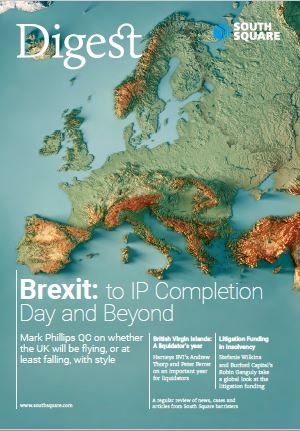

Throughout the Brexit saga I have compared the process to a stressful car journey with noisy children fighting in the back. I cannot describe 11pm on Friday 31st January 2020 as the arrival of our surviving travellers at their final destination. They might be said to have driven to the airport, boarded the aircraft and left airport EU, but where they might land is something we will discover over the rest of 2020. The UK has passed through the door marked ‘exit’ and is no longer a Member State of the EU. However, until after completion of the “implementation period”1, and probably beyond2, the UK will continue to apply EU laws. The “implementation period” is the “transition or implementation period… beginning with exit day and ending on IP completion day, 31st December 2020.”3 During that period the UK and the EU will work towards entering into the more permanent arrangements to which the UK and the EU aspired in the Political Declaration. For the period following completion of the Implementation Period the provisions that would have applied following exit day under the original Withdrawal Act will, in broad terms, and subject to agreements in the meantime, apply. Those provisions are likely to be superseded by agreements made during the implementation period. In the context of insolvency and restructuring it would be surprising if no agreement could be made in the next 11 months to replicate, as between the UK and the EU, the provisions of the EU Insolvency Regulation, particularly given that absent agreement, the EU Insolvency Regulation will become UK domestic law. There are now four sources of the rules that govern our legal relationship with the EU in the future. The European Communities Act 1972 (the “ECA 72”), which will not be repealed in full until after the IP completion day, the European Union (Withdrawal) Act 2018 (the “Withdrawal Act”), that has in turn been amended and supplemented by the European (Withdrawal Agreement) Act 2020 (the “Withdrawal Agreement Act”), which in turn gives effect to the withdrawal agreement.4 There is also the Political Declaration but that does not give rise to present legal rights or obligations during the implementation period. The Political Declaration5 is important in assessing what the UK’s relationship will be after the end of the implementation period, the “IP Completion Day”.6
The European Union (Withdrawal) Act 2018
For the next 11 months, whilst we keep one eye on the negotiations for the future relationship between the EU and the UK, the UK will continue to apply parts of the ECA 72. After completion of the implementation period, subject to any agreements made in the meantime, the UK will apply domestic law that incorporates provisions of EU law that are operative on IP Completion Day.
Part 1: the laws applicable during the Implementation Period
The continued application of the European Communities Act 1972 during the implementation period
The ECA 72 is repealed on exit day7 but there is now an important saving for the implementation period. The Withdrawal Agreement Act introduced sections 1A and 1B into the Withdrawal Act: “1A(2) The European Communities Act 1972, as it has effect in domestic law .. immediately before exit day, continues to have effect in domestic law or the law of the relevant territory on and after exit day so far as provided by subsections (3) to (5) .8 Section 1A(3) provides that the ECA 72 has effect on and after exit day as if references to “the Treaties” and “the EU Treaties” included part 4 of the withdrawal agreement, but are otherwise limited to anything falling within the definitions before exit day and “so far as it is not excluded by regulations made on or after exit day by a Minister of the Crown9. The UK is treated “as if it were a member of the EU during the implementation period.10 For the implementation period this replaces section 3 of the Withdrawal Act, which originally applied from exit day. Rather than incorporate EU laws into UK domestic laws, which is the mechanism adopted by section 3 of the Withdrawal Act, section 1A continues the effect of the European Communities Act 1972, by reference to EU law on exit day until IP Completion day. It is a relatively simple transition provision. In addition, section 1B of the Withdrawal Act provides for further savings for EU derived domestic legislation during the Implementation Period. EU derived domestic legislation, as it has effect in domestic law immediately before exit day, continues to have effect in domestic law on and after exit day.11 The EU derived legislation12 is to be read “so far as the context permits” as if references to EU law and related matters “were a reference so far as it is applicable to and in the UK by virtue of Part 4 of the withdrawal agreement.13
Saving provision during the Implementation Period
Section 8(1) of the Withdrawal Act provided that a Minister of the Crown may by regulations make such provision as the Minister considers appropriate to prevent, remedy or mitigate any failure of retained EU law to operate effectively, or any other deficiency in retained EU law, arising from the withdrawal of the UK from the EU. The Withdrawal Agreement Act has added section 8A of the Withdrawal Act. That gives a Minister the power by regulations to provide for modifications14, or to disapply subsections 1B(3) or (4)15 to particular cases or descriptions of cases16 and make different provision in such cases17 and to “make such provision not falling within paragraph (a), (b), (c) or (d) as the Minister considers appropriate for any purpose of, or otherwise in connection with Part 4 of the withdrawal agreement.18 Schedule 7 of the Withdrawal Agreement Act provides for Parliamentary scrutiny of the power under section 8.19
Review of new EU laws during the Implementation Period
During the implementation period provision has been made for the review of EU legislation.20 A review is triggered by the European Scrutiny Select Committee of the House of Commons (“the ESSC”). If the ESSC publishes a report in respect of any EU legislation made, or which may be made during the implementation period that (a) states that in the opinion of the ESSC the EU legislation raises a matter of vital national interest to the UK, (b) confirms that the ESSC has taken such evidence as it considers appropriate as to the effect of the EU legislation and has consulted any Departmental Select Committee of the House of Commons which the ESSC considers also has an interest in the EU legislation and (c) sets out the wording of a motion to be moved in the House of Commons,21 a Minister must22 make arrangements for the proposed motion to be debated and voted on by the House of Commons.23 This provision is necessary because of the different mechanism introduced by the Withdrawal Agreement Act. Leaving the ECA 72 in force leaves the UK subject to new EU laws introduced during the implementation period. The previous mechanism crystallised EU law on exit day and incorporated that into UK laws. Given that EU laws will change during the implementation period, this provision is necessary. The review procedure gives the UK the opportunity not to adopt new EU provisions if those provisions raise an issue of vital national interest. In the insolvency context 2019 saw the introduction of the EU Restructuring Directive (EU/2019/1023). Whilst it does not appear likely that further insolvency related directives will be introduced during 2020, it is unlikely that they would raise issues of vital national interest, so they will become part of the retained EU law that is adopted by the UK under section 3 of the Withdrawal Agreement on IP Completion day.
The rights, liabilities, obligations and restrictions arising under the Withdrawal Agreement
The Withdrawal Agreement Act was passed with little debate. Amongst the new provisions is one that has not yet received much attention but which appears to be of potential far reaching effect. Rather than the mechanism previously in the Withdrawal Act, namely, the adoption into UK laws of EU law as it stood on exit day,the Withdrawal Agreement Act adopts a different mechanism; the ECA 72 continues in force during the transitional period but is subjected to the terms of the Withdrawal Agreement. The Withdrawal Act (as amended by the Withdrawal Agreement Act) gives legal effect to the “rights, liabilities, obligations and restrictions” from time to time created or arising by or under the withdrawal agreement.24 Section 7A(2) provides: “(2) The rights, powers, liabilities, obligations, restrictions, remedies and procedures concerned are to be –
(a) recognised and available in domestic law, and
(b) enforced, allowed and followed accordingly.”
On its face this could give rise to numerous claims by individuals or legal entities asserting that things have been done that infringe their rights that arise as a result of the withdrawal agreement. The Explanatory notes say that “where provisions of the Withdrawal Agreement (or EU law made applicable by it) are capable of having direct effect, the Bill enables legal or natural persons to rely directly on those provisions in UK courts.” Enforcement is “available in domestic law”, and the power to enforce is generally available. It is intended to apply to all “powers, liabilities, obligations, restrictions, remedies and procedures” that are capable of having direct effect.25 Article 4 of the Withdrawal Agreement informs the scope of section 7A: “1. The provisions of this Agreement and the provisions of the Union law made applicable by this Agreement shall produce in respect of and in the [UK] the same legal effects as those which they produce within the Union and its Member States. Accordingly, legal or natural persons shall in particular be able to rely on the provisions contained or referred to in this Agreement which meet the conditions for direct effect under Union law.” The Explanatory Notes say that section 7A “makes the rights and obligations etc. In the Withdrawal Agreement available in domestic law.26 The test of enforceability is first determined by reference to whether or not the right has direct effect. However, section 7A does not only apply only to the EU laws given effect by the Withdrawal Agreement, it applies to the Withdrawal Agreement itself. Article 4 provides that the right to rely on provisions which meet the conditions of direct effect under EU law is “in particular”. It could go wider. It should be possible to spell out of the Withdrawal Agreement rights and obligations that can then be enforced.
In an insolvency context, during the implementation period the EU Insolvency Regulation continues in force as if the UK was a Member State. After IP completion day the EU Insolvency Regulation will become UK domestic law (unless it is superseded) and in the UK it will continue to operate, although the UK will be a third country rather than a Member State27. There is no need in that context to rely upon rights given by the Withdrawal Agreement because the relevant rights are found in the EU Insolvency Regulation as applied in the UK. However, there could be other rights, and section 7A could give rise to claims by individuals asserting that things have been done that infringe their rights that arise as a result of the withdrawal agreement. If it can be shown that an individual’s rights or powers found in the withdrawal agreement have been infringed, or that they should have a remedy, on the face of it that is enforceable. The Prime Minister has said that absent a new agreement the UK will rely on the rights contained in the withdrawal agreement. It is possible that every UK citizen will be able to rely on rights in the withdrawal agreement. It follows that the withdrawal agreement should be analysed through the prism, that of identifying individuals’ rights and possibly liabilities, to assess whether or not they are enforceable under section 7A.
In addition section 7(3) provides that “every enactment (including an enactment contained in this Act) is to be read and has effect subject to subsection (2).” Again, this is a general provision. This gives effect to article 4(2) of the Withdrawal Agreement: “The [UK] shall ensure compliance with paragraph 1, including as regards the required powers of its judicial and administrative authorities to disapply inconsistent or incompatible domestic provisions, through domestic primary legislation.” On its face it requires the UK courts
to read every enactment, whatever its content, subject to the withdrawal agreement.
The Withdrawal Agreement and insolvency
The objective of the withdrawal agreement “is to ensure an orderly withdrawal of the [UK] from the [EU]28. The withdrawal agreement is 584 pages long. In addition to assessing what it says, we need to identify the “rights, powers, liabilities, obligations, restrictions, remedies and procedures”. The preamble recognises that EU citizens and UK nationals “have rights under [the withdrawal agreement] that are “enforceable and based on the principle of nondiscrimination.”
That recognition indicates that the rights enforceable under section 7A include at least those types of right. There are numerous rights contained within the Withdrawal Agreement that could be important in an insolvency context, and as 31st December 2020 approaches a great deal of detailed analysis will be required.29 Ongoing Judicial cooperation in Civil and Commercial Matters is dealt with in Part 3, Title VI of the Withdrawal Agreement.30 Rome I31 applies to contracts concluded before the IP Completion date32 and Rome II33 applies to events occurring before the end of the transition period34. The Recast Brussels Regulation35 continues to apply to questions of jurisdiction in respect of legal proceedings instituted before the end of the transition period and in respect of proceedings36 or actions that are related to such legal proceedings. The Recast Brussels Regulation37 will also apply to the recognition and enforcement of judgments given in legal proceedings instituted before the end of the transition period and to court settlements approved or concluded before the end of the transition period.38 The EU Insolvency Regulation39 shall apply to insolvency proceedings in “situations involving the United Kingdom”40, and to actions deriving directly from insolvency proceedings and closely linked to them41, provided that the main proceedings are opened before end of the transition period42. Depending upon the arrangements following IP Completion day, there may be a number of filings before 31st December 2020 to secure recognition in the EU Member States.
Part 4 of the Withdrawal Agreement
Section 1A(3) provides that the ECA 72 has effect on and after exit day as if references to “the Treaties” and “the EU Treaties” included Part 4 of the Withdrawal Agreement. Part 4 of the Withdrawal Agreement is the Transition provisions. Article 127 provides that during the transition period EU law “shall be applicable to and in the UK during the transition period.” The main operative provision of Part 4 is article 127(1) which provides that “unless otherwise provided in this Agreement, Union law shall be applicable to and in the United Kingdom during the transition period.” The applicable EU law produces the same legal effects in the UK as those which it produces within the EU and Member States and it is to be interpreted accordingly.43
Part 2: the applicable laws after the Implementation Period
Adoption into UK domestic law of EU laws applying on IP Completion day
Section 3(1) of the Withdrawal Act now applies after IP Completion day: “Direct EU legislation, so far as operative immediately before IP Completion day, forms part of domestic law on and after IP Completion day.” Section 3(1) of the Withdrawal Agreement Act has been amended so that section 3(1) applies from IP Completion day, the period after the transition period44. As explained above, this mechanism is different to the mechanism in place during the Implementation Period. During the transition period sections 1A and 1B continue to apply the ECA 72 (subject to the withdrawal agreement). Section 3 will incorporate into English law Direct EU legislation on or after IP Completion day. The starting point to how this will operate is to identify what is “direct EU legislation” and section 3(2) provides that it is “any EU regulation, EU decision or EU tertiary legislation as it has effect in EU law immediately before IP Completion day so far as it is applicable to and in the UK by virtue of Part 4 of the withdrawal agreement.”45 It is only the English language version of direct EU legislation that will be brought into domestic law.46 In the insolvency context, absent any agreements made between now and 31st December 2020, the EU Insolvency Regulation will become part of the UK’s domestic laws (in whatever form it is in on 31st December 2020). In that sense there will not be a ‘hard brexit’47 in relation to insolvency.48 The law then operative will become part of the UK’s
domestic laws. The UK will no longer be a member state, so the application of the EU Insolvency Regulation will be lop sided; the UK will apply it to EU Member States, but EU Member States will apply it as if the UK is a third country and not a Member State.
Savings
Section 3(5) of the Withdrawal Act provides that the incorporation into English law of EU law is subject to the provisions of section 5 of the Withdrawal Act. Whilst the concept of EU supremacy does not apply to any enactment or rule of law passed or made on or after IP Completion day it continues to apply so far as relates to the interpretation, disapplication or quashing of any enactment or rule of law passed or made before IP Completion day.49
EU Regulations forming part of UK law
Direct EU legislation is operative immediately before IP Completion day if it is in force and applies immediately before IP Completion Day.50 Section 15 and schedule 5 of the Withdrawal Act make provision for the publication of copies of “direct EU legislation and related information”.sup>51 This includes EU regulations, EU decisions and EU tertiary legislation.52 In the insolvency context, this means that copies should be produced of the domestic law version of the Recast EU Insolvency Regulation (2015/848).53
EU Decisions forming part of UK law
Decisions are operative immediately before exit day if it has been notified to the person before IP Completion Day.54The Withdrawal Act provides that there may be publication of copies of “any decision of, or expression of opinion by the CJEU” or “any other document published by an EU entity”55 Given that there is general access to decisions of the CJEU, it is unlikely to be necessary to exercise this power.
Interpretation and Status of retained EU law
The English Court is not bound by any principles laid down or decisions made by the CJEU56 after IP completion day, and will no longer refer any matter to the CJEU. Section 6(2) of the Withdrawal Act provides that a court or tribunal may have regard to anything done on or after IP Completion day by the CJEU, another EU entity or the EU, so far as it is relevant to any matter before the court or tribunal. In so far as the law is unmodified, questions as to the validity, meaning or effect of any retained EU law is to be decided in accordance with any retained case law and any retained general principles of EU law, and having regard (among other things) to the limits, immediately before IP Completion day, of EU competences.57 This could prove significant in the context of the interpretation of the EU Insolvency Regulation. The definition of the COMI is a fundamental concept from which much of the application of the EU Insolvency Regulation flows. That definition is unlikely to change.58 The effect of section 6(3) of the Withdrawal Act is that the case law and general principles applicable in the EU in relation to the COMI will be applied by the English courts. If there is uniformity across the EU27 and the UK in the application of the COMI, it is less likely that there could be a conflict between the English and EU courts in the insolvency and restructuring context. Whilst COMI is the most significant example, there will be many others. Whilst the UK’s courts will continue to make decisions in accordance with some EU cases and principles, and will have regard to those cases and principles, the Supreme Court will not be bound by any retained EU case law59 and the High Court will not be bound by any retained EU case law in certain criminal matters and in relation to “retained domestic case law”60 In deciding whether to depart from any retained EU case law, the Supreme Court or the High Court must apply the same test as it would apply in deciding whether to depart from its own case law.61 The application of the case law and general principles make it very unlikely that an English court would make a decision contrary to a decision of an EU court. If the English court is aware that its decision would conflict with a decision of an EU court the English court is bound to need a great deal of persuasion, if it can be persuaded at all. Section 7 of the Withdrawal Act provides that primary or subordinate legislation or other enactments continue to be domestic law on and after IP Completion day as an enactment of the same kind and sets out how such legislation can be amended. There is provision for rules of evidence, judicial notice and admissibility. The detailed rules in part 2 of schedule 5 to the Withdrawal Act provide that where it is necessary, for the purpose of interpreting retained EU law in legal proceedings, to decide a question as to the meaning or effect in EU law of the validity meaning or effect in EU law of any EU enactment, which will include the EU Insolvency Regulation, the question is to be treated as a question of law and not a question of fact.65 The practical consequence of this provision will be that questions, for example of the meaning of the COMI as a matter of EU law, will be addressed by submission based upon EU law up to IP Completion date and not upon expert evidence from lawyers in the EU27 countries. English practitioners will not only need to remain current on questions of EU retained law up to 31st December 2020, but will have to maintain that knowledge for so long as the concepts, such as the COMI, remain current. There are also enabling provisions about judicial notice and admissibility. A Minister may by regulations make provision enabling or requiring judicial notice to be taken of a ‘relevant matter’,66 or provide for the admissibility of specified evidence of a ‘relevant matter’, instruments or documents67. ‘Relevant matter includes EU law and retained EU law.68
Part 3: future negotiations
Article 184 of the Withdrawal Agreement provides:
“The Union and the United Kingdom shall use their best endeavours, in good faith and in full respect of their respective legal orders, to take the necessary steps to negotiate expeditiously the agreements governing their future relationship referred to in the political declaration of 25/11/2018 and to conduct the relevant procedures for the ratification or conclusion of those agreements, with a view to ensuring that those agreements apply, to the extent possible, as from the end of the transition period.” The obligation is to use best endeavours, in good faith to negotiate. It is not the firmest of commitments. However, the question must already have arisen whether conducting the negotiations by press conference, stating publicly in advance what the red lines are, and why there is insufficient time to do a deal, complies with this obligation.
The Political Declaration
The Political Declaration is said to establish “the parameters of an ambitious, broad, deep and flexible partnership across trade and economic cooperation, law enforcement and criminal justice, foreign policy, security and defence and wider areas of
cooperation.69 It is 26 pages long and sets out a high level objectives. Those objectives recognise the “particularly important trading and investment relationship” between the UK and the EU.70 Whilst there is no reference to insolvency matters there are three aspects of the Political Declaration that should inform the likely future shape of the relationship between the UK and the EU in relation to insolvency matters, trade, services and investment and financial services. The trading relationship is intended to be “as close as possible, with a view to facilitating the ease of legitimate trade.”71 The EU and the UK envisage comprehensive arrangements that will create a free trade area, combining deep regulatory and customs cooperation, underpinned by provisions ensuring a level playing field for open and fair competition 72 The economic partnership between the EU and the UK “should ensure no tariffs, fees, charges or quantitative restrictions across all sectors, with ambitious customs arrangements that… build and improve on the single customs territory provided for in the Withdrawal Agreement which obviates the need for checks on rules of origin.73 This appears to envisage a high degree of alignment between the UK and EU. As regards services and investment the UK and the EU “should conclude ambitious, comprehensive and balanced arrangements on trade in services and investment in services … respecting each [of the EU and the UK]’s right to regulate…” and the UK and the EU “aim to deliver a level of liberalisation in trade and services and well beyond the Parties’ World Trade Organisation commitments.74 There are three paragraphs under the heading “Financial Services”.75 The concept at its heart is equivalence. There is a commitment “to preserving financial stability, market integrity, investor and consumer protection and fair competition, while respecting the Parties’ regulatory and decision making autonomy, and their ability to adopt or maintain any measure where necessary for prudential reasons.76 It is intended that equivalence assessments should start with a view to concluding those assessments by June 202077 and it is agreed that “close and structured cooperation on regulatory and supervisory matters is in the UK and EU’s mutual interest.”78 Whilst these provisions are specific to Financial Services, the concept of equivalence is likely to be
applied in the context of the futurerelationship between the UK and the EU in insolvency matters. Modified universalism, a form of equivalence in that it results in a system that applies different, but sufficiently equivalent, aspects of insolvency regimes to a cross border insolvency, rather than apply a single universal system of rules to every aspect. Taken together with the provisions in the Political Declaration on trade and services and investment, there is a strong argument that, in the context of cross border insolvency, the effect of the EU Insolvency Regulation is consistent with the intention behind the Political Declaration and should be adopted in a new bi-lateral cross border insolvency treaty, after IP completion date, that applies across the EU27 and the UK to continue to give continuing effect to the present arrangements.
Conclusion: flying or falling with style?
The car journey in Toy Story ends with Buzz Lightyear about to re-unite with Andy, his kid, with the response to Woody’s “Buzz, you’re flying”, “This isn’t flying, it’s falling with style”. As the UK and EU go beyond IP Completion date will we be flying or falling with style? In the insolvency context there is a system applicable in the context of cross border insolvencies that now avoids the costs and pitfalls of separate territorial insolvency regimes. As Sir Nicholas Browne Wilkinson VC said in July 1991 when faced with liquidations of BCCI in several jurisdictions “there must be a better way”. Between now and December 2020 it should be possible for the UK and EU to enter into similar arrangements. The same is true of the arrangements on recognition and enforcements of Judgments. If that is achieved we will be flying, or at the very least, falling with style.
1As a result of the new mechanism in the saving of parts of the European Communities Act 1972 during the implementation period.
2As explained below,section 3 of the Withdrawal Act provides that the operative provisions of EU law on completion of the Implementation Period become UK domestic law. That will be affected by two things, what the operative provisions are on that date and whether the have been superseded by agreements between the EU and the UK.
3Section 1A of the Withdrawal Act, introduced by section 1 of the Withdrawal Agreement Act.
4The “Agreement on the withdrawal of the United Kingdom of Great Britain and Northern Ireland from the European Union and the European Atomic Energy Community, as endorsed by leaders at a special meeting of the European Council on 25 November 2018”.
5The “Political Declaration setting out the framework for the future relationship between the European Union and the United Kingdom”.
6“IP completion day” means 31 December 2020 at 11.00 p.m (section 39(1) Withdrawal Agreement
Act 2020). References in the Withdrawal Agreement Act 2020 to “before, after or on IP completion day, or to beginning with IP completion day, are to be read as references to before, after or at 11.00 p.m. on 31 December 2020 or (as the case may be) to beginning with 11.00 p.m. on that day (section 39(2)Withdrawal Agreement Act 2020).
7Section 1 of the Withdrawal Act.
8Subsections (3) to (5) deals with references to treaties, objects of the EU and ancillary matters that are necessary because the UK is no longer a Member State.
9Section 1A(3)(a) of the Withdrawal Act.
10Section 1A(3)(e) of the Withdrawal Act.
11Section 1B(2) of the Withdrawal Act.
12EU derived domestic legislation is defined in section 1B(7) of the Withdrawal Act. In essence it is legislation made under or for a purpose mentioned in the ECA 72.
13Section 1B(3) of the Withdrawal Act
14Sections 8A(1) (a) and 1(B)(3)(f)(i) of the Withdrawal Act. This is not limited to modifications necessary for part 4 of the Withdrawal Agreement which is provided for expressly in 1(B)(3)
(f)(ii).
15EU-derived domestic legislation both before and after exit day, up to IP completion day.
16Section 8A(1)(b) of the Withdrawal Act.
17Section 8A(1)(c) of the Withdrawal Act.
18Section 8A(1)(e) of the Withdrawal Act.
19This power continues for 2 years after the IP Completion day, section 8A(2) of the Withdrawal Act.
20Section 13A of the Withdrawal Act introduced by section 29 of the Withdrawal Agreement Act. This includes amendments to the EU Treaty, and any new EU Regulations and EU Directives.
21Section 13A(1) of the Withdrawal Act.
22Within 14 Commons sitting days beginning with the day on which the report is published.
23Section 13A(2) of the
Withdrawal Act. There are similar provisions requiring motions to be debated by the House of Lords (section 13A(3) and (4) of the Withdrawal Act).
24Section 7A of the Withdrawal Act, introduced by section 5 of the Withdrawal Agreement Act.
25Provisions meeting the conditions of direct effect is referred to in article 4 of the Withdrawal Agreement.
26Paragraph 121 of the Explanatory Notes.
27I have analysed the effect of this change in previous articles in the Digest.
28Preamble.
29For example, the rights of EU professionals, lawyers or accountants being
the most obvious, to practice in the UK is protected, and those rights are
enforceable by those professionals. In the context of a trading insolvency Articles 40 to 42 provide for the continuing circulation of goods placed on the market before the IP completion date. Article 41 provides that “any good lawfully placed on the in the [EU] or the [UK] before
the end of the transition period” may be made available in the EU or the UK until they reach its end user or may be put into service either in the EU or the UK. If an insolvent company has goods circulating in the EU before 31st December 2020, they continue to be available to the company.
30Articles 66 to 69.
31Regulation (EC) No 593/2008.
32Article 66(1)(a) of the Withdrawal Agreement.
33Regulation (EC) No 864/2007.
34Article 66(1)(b) of the Withdrawal Agreement.
35Regulation (EU) No. 1215/2012.
36Article 67(1)(a) of the
Withdrawal Agreement.
37Regulation (EU) no 1215/2012.
38Article 67(2)(a) of the Withdrawal Agreement. It is arguable that there is a lacuna in that jurisdiction over proceedings will be taken under the Recast Brussels Regulation provided that the proceedings are commenced before 31st December 2020, but the recognition of court settlements depends on the court settlement being “approved or concluded” before 31st December 2020. The recognition of court settlements would have been better linked to the proceedings. It is possible that there will be proceedings commenced before 31st December 2020 a judgment made in such proceedings would fall within article 67(2)(a) and would be recognised, but a court settlement would not be recognised because it will have been “approved or concluded” after 31st December 2020.
39Regulation (EU) 2015.848.
40Article 3 of the Withdrawal Agreement.
41Referred to in Article 6(1) of the EU Insolvency Regulation (EU) 2015/648.
42Article 67(3)(c) of the Withdrawal Agreement.
<sup<43Article 127(3) of the Withdrawal Agreement.
44IP Completion Day was substituted for exit day by section 25(2) of the Withdrawal Agreement Act.
45The reference to the withdrawal agreement was inserted by second 25(2)(b)(ii) of the Withdrawal Act. There are exceptions to this definition. It does not include “exempt EU instruments” which are defined in section 20(1) and schedule 6 to the Withdrawal Act, which in broad terms is EU instruments that are not applicable to the UK or it does not include decisions that are not applicable to
the UK. There are also exclusions relevant to the EEA Agreement that fall outside the scope of this article.
46Section 3(4) of the Withdrawal Act. This does not affect the use of other language versions of legislation for the purposes of interpreting the English language version as a matter of English law.
47By a ‘hard brexit’ I mean a brexit in which there are no applicable rules between the UK and the EU.
48The same will be true for many other areas.
49Section 5(1) and (2) of the Withdrawal Act.
50Section 3(3)(a) of the Withdrawal Act.
51Section 15 and schedule 5 of the Withdrawal Act.
52Schedule 5 of the Withdrawal Act.
53There will be no need to publish copies of the EU Directives that have been implemented by UK legislation. The extent to which UK laws diverge from those EU Directives after the IP Completion Date is one of the questions that arises during the Implementation Period.
54Section 3(3)(b) of the Withdrawal Act.
55Schedule 5 para 1(3) of the Withdrawal Act.
56Section 6(1) and (2) of the Withdrawal Act 2018. Article 86(2) of the Withdrawal
Agreement provides that the CJEU shall continue to have jurisdiction to give preliminary rulings on requests from UK courts and tribunals made before the end of the transition period.
57Section 6(3) of the Withdrawal Act. Subsection (3) does not prevent the validity, meaning or effect of any retained EU law which has been modified on or after IP Completion day from being decided if doing so is consistent with the intention of the modifications.
58An indication that this will not be changed is found in the Insolvency (Amendment) (EU Exit) Regulations 2018 which did not alter the definition of the COMI in the context of a ‘no deal’ Brexit.
59Section 6(4)(1) of the Withdrawal Act.
60Defined in section 6(4)(b) of the Withdrawal Act. The Withdrawal Agreement Act has also introduced the possibility that courts or tribunals may not be bound by retained EU case law following regulations passed under section 5A of the Withdrawal Act (section 26(1)(b) of the Withdrawal Agreement Act). A Minister may by regulations provide “the extent to which, or circumstances in which, a relevant court or relevant tribunal is not to be bound by retained EU case law, or the test which a relevant court
or relevant tribunal must apply in deciding whether to depart from any retained EU case law.” (section 26(1) (d) of the Withdrawal Agreement Act). A Minister is obliged to consult the senior judiciary before making regulations.
61Section 6(5) of the Withdrawal Act.
62Section 15(2) of the Withdrawal Act.
63Section 4 of the Withdrawal Act.
64Interpreting EU law means deciding any question as to the validity, meaning and effect of any retained EU law.
65It also applies to the meaning and effect of EU Treaties or any other treaty relating to the EU.
66Section 4(1)(a) of the Withdrawal Act.
67Section 4(1)(b) of the Withdrawal Act.
68Section 4(5) of the Withdrawal Act.
69Political Declaration paragraph 3.
70Political Declaration paragraph 16.
71Political Declaration paragraph 20.
72Political Declaration paragraph 22. This should be compared to public statements made during January 2020.
73Political Declaration paragraph 23.
74Political Declaration paragraph 29.
75Political Declaration paragraphs 37 to 39.
76Political Declaration paragraph 37.
77Political Declaration paragraph 38.
78Political Declaration paragraph 39. Paragraph 37 refers to close cooperation on regulatory and supervisory matters in international bodies, which will include the Basel Committee on Banking Supervision.
79There will be difficult questions. For example, the present system depends upon a single decision on the COMI of a company from which many of the subsequent rules governing the insolvency follow. Under the present system a conflict between the Courts of the Member States on that question can be resolved, ultimately at CJEU level. The question how a conflict between a UK court and the court of a Member State over the COMI should be resolved is not straight forward.
Current political statements make it highly unlikely that the UK would agree to final determination by
CJEU. An alternative approach would be to look to the position under the UNCITRAL Model Law in the context of which there have been such conflicts but no final binding arbiter and the courts in the different jurisdictions have worked to avoid them.







![Brake & Anor v The Chedington Court Estate Ltd [2023] UKSC 29](https://southsquare.com/wp-content/uploads/2024/02/Brake-Anor-scaled-e1728649908896.jpeg)








![New Judgment: Re Argentex LLP [2025] EWHC 3125 (Ch)](https://southsquare.com/wp-content/uploads/2025/06/alejandro-pohlenz-gYbOFTwcJx4-unsplash-scaled.jpg)
